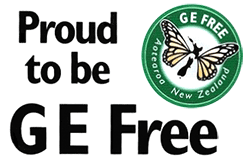The media hype surrounding hopes to one day use GE clover for reduction in methane emissions ignores existing solutions and will not change the importance of keeping New Zealand agriculture GM-free.
Waiting another 15 years of GE development is no magic bullet that can overcome the need for a whole-of-systems approach to improving resilience in the primary sector by protecting our clean, green, natural brand image.
�Planting a range of mixed forage pastures can be done today, said Claire Bleakley, president of GE Free NZ in food and environment. �All farmers will be able to have guaranteed entry into export markets as their products will be GE Free, have no technology costs, and be free of GE contamination.�
Outcomes from traditional pasture research over the last 30 years have been undervalued and ignored, but we have a vast range of mixed leys and forage pastures that are safe and GE-Free.
Many of the diverse alternative legume forages like, Sulla, lotus, red and white clover, chicory, willow and poplar and other grasses have been overlooked while farmers are told that the proposed monoculture GE pasture management is the way to go.
Research on these forages has shown not only a large reduction in methane emissions but also an improvement in resistance to intestinal parasites in cows and sheep.
A Dairy cow produces up to 90kgs methane per annum (1) so planting pasture that includes legumes and mixed leys can benefit farmers reduce methane emissions and increase milk yields significantly (2)right now.
The ability to stop GE clover and grasses out-crossing and contaminating other similar species plants will only be a matter of time. The frightening juggernaut of �science based technologies synthetic technological fix� will be impossible for New Zealand farmers to preserve a clean green safe food nation.
New Zealand primary production must remain GE-free. International rejection of GE food by many consumers is unlikely to change given the dangers of the experimental GE processes used in the laboratory, and inadequate understanding of complex genetic and environmental effects.
�Deformities in animals used in GE experiments have already cast a shadow over AgResearch's work, and it is time to halt misdirected investment in GE that comes at the expense of alternative research and development,� said Jon Carapiet, spokesperson for GE Free NZ in food and environment. "Another 15 years of GE animals and GE clover-development is a mistake. The research should be redesigned to focus on maintaining our GE-free status as a food producer.�
The real problem is not the cows which have to belch methane as part of their digestion and milk production, but excessive herd numbers and failing to plant superior diverse alternative forage systems.
Money invested in helping farmers to implement these pasture systems right now will benefit New Zealand far more than hyped promises for a GE magic bullet.
ENDS:
Jon Carapiet 0210507681
Claire Bleakley 06 3089842 027 348 6731
References:
(1) Methane Mitigation. http://www.dairynz.co.nz/file/fileid/5873
White clover results in significantly better animal performance than the common forage grasses and less common species such as sulla and chicory have also been found to be superior to grasses (e.g. Waghorn & Sheldon 1997). AgResearch and Dexcel have measured methane production from animals grazing alternative forage species (e.g. lotus, sulla) and these indicate that they do produce less methane per unit of feed intake than other common New Zealand forages (Woodward et al. 2001). In the case of lotus and sulla, the ability to reduce methane output per unit of feed intake is thought to be a consequence of these plants having high concentrations of condensed tannins �
(2) Woodward SL., Laboyrie P J and Jansen E, Lotus Corniculatus and Condensed Tannins � Effects on Milk Production by Dairy Cows, Asian-Aus. J. Anim. Sci. 13 Supplement July 2000 A: 521-525 HYPERLINK "http://www.asap.asn.au/livestocklibrary/2000/Woodward_0641.pdf" http://www.asap.asn.au/livestocklibrary/2000/Woodward_0641.pdf
(3) Potential management practices and technologies for reducing methane emissions from agriculture http://www.maf.govt.nz/mafnet/rural-nz/sustainable-resource-use/climate/green-house-gas-migration/ghg-mitigation-05.htm
(4) Ramirez-Restrepo, Barry T, 2005, Alternative temperate forages containing secondary compounds for improving productivity in grazing ruminants, Vol: 120, 3, pp 179-201 http://www.animalfeedscience.com/article/PIIS0377840105000738/fulltext#back-cor1 |


